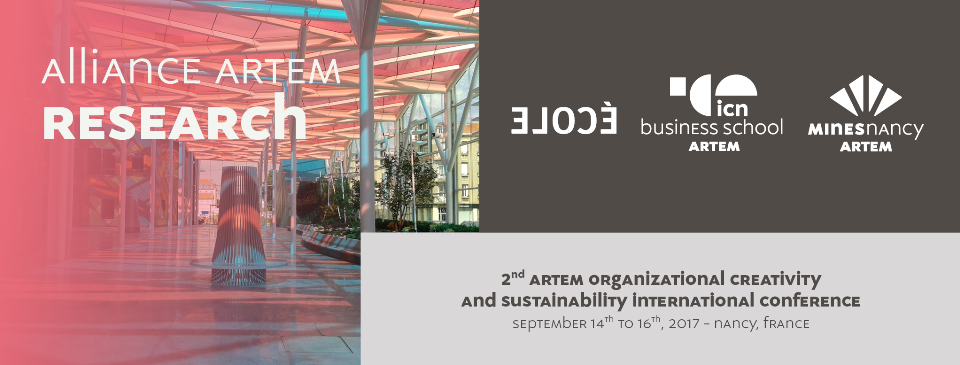
|
|
|
list of sub-themes > sub-theme 10SUB-THEME 10: TRANSDISCIPLINARY AND INTERCULTURAL INNOVATION FOR SUSTAINABLE DEVELOPMENT To upload your abstract, please log in.
convenors: Stefan Huesig
Chemnitz University of Technology,Germany
Julien Bucher
Chemnitz University of Technology, Germany
Heike Wörner
University of Regensburg, Germany
Henry Wissink
University of Kwazulu Natal, Durban, South Africa
objective: In this conference track we aim to bring various scholars and additional stakeholders together under this joint vision to further explore these boundary-crossing subjects. We are especially interested in research that offers new insights into innovation processes that cross cultural and disciplinary borders - especially between art and technology - for a sustainable impact on society. description: Art, innovation and technology are generally considered vital indicators of civilization, yet their advances are typically considered separately. In recent years social innovation and aesthetic culture has attracted more research interest, in which the value often is understood to reside in symbolism and meaning but was mainly motivated by economic growth agendas of governments to stimulate and promote cultural or creative industries. Our understanding goes beyond that: To radically innovate of any kind, it is of paramount importance to dissolve disciplinary and functional boundaries, connect formerly unconnected knowledge and applications fields or overcome thought barriers and break existing paradigms. Transdisciplinary approaches typically involve nonscientists in the production and/or evaluation of knowledge and explicitly orient their knowledge production not only around disciplinary problem-definitions but also around other definitions, derived from pressures, applications or from societal stakeholders. Moreover, new combinations frequently emerge by crossing cultural and geographic borders that enable further learning on various levels of the society and offer an improvement towards sustainable development locally. We are especially interested in research that offers new insights into innovation processes that cross cultural and disciplinary borders - especially between art and technology - for a sustainable impact on society. Specially but not limited to the following subjects: - Transdisciplinary collaborations between art, technology & innovation - Sustainable and (inter-)cultural innovation, e.g. Frugal, BOP, Reverse, Catalytic Innovation - Radical, social and disruptive innovation and (inter-)cultural collaborations keywords: Transdisciplinary collaborations, art, R&D, sustainable innovation, cross/inter-cultural collaborations, radical innovation
references: Stüer, C.; Hüsig, S.; Biala, S. 2010: Integrating Art as a Trans-boundary Element in a Radical Innovation Framework, in: R&D Management, 40, 1, 10-18 (Special Issue: Emerging Methods in R&D Management). Derrick Tate, Designing Transdisciplinary Discovery and Innovation: Models and Tools for Dynamic Knowledge Integration, Transdisciplinary Journal of Engineering & Science, Vol. 1, pp. 93-110, (December, 2010). Birgitte Rasmussen, Per Dannemand Andersen and Kristian Borch, Managing Transdisciplinarity in Strategic Foresight, CREATIVITY AND INNOVATION MANAGEMENT, Volume 19, Number 1, 2010 Jörg Reckhenrich, Martin Kupp, Jamie Anderson (2009) Understanding creativity: The manager as artist Business Strategy Review 20(2, May): 68–73. Jonathan Sapsed, Feichin Ted Tschang, Art is long, innovation is short: Lessons from the Renaissance and the digital age, Technological Forecasting & Social Change, 83 (2014) 127–141 Schimpf, S. and Sturm, F. (2010): Art and R&D: a conceptual approach on how art can support the product development process. Proceedings of the R&D Management Conference, Manchester, UK, 30.06 – 2.07.2010. Biswas, A. (2008) ‘Managing art–technology research collaborations’, Int. J. Arts and Technology, Vol. 1, No. 1, pp.66–89. Xerox PARC Artist-in-Residence-Program, Cambridge, Massachusetts Wilson, S. 2002: Information arts. Intersections of art, science and technology, Cambridge, Massachussetts. Styhre, A.; Eriksson, M. 2008: Bring in the Arts and Get the Creativity for Free: A Study of the Artists in Residence Project. Creativity and Innovation Management, Jg.17, Nr. 1, S.47-57. Haner, U.-E. 2005: Spaces for Creativity and Innovation in Two Established Organizations. Creativity and Innovation Management, Jg. 14, Nr. 3, S.288–298. Harris, C. 1999: Art and innovation. The Xerox PARC artist-in-residence program, Cambridge, Mass. Florida, R. 2006: The rise of the creative class. And how it's transforming work, leisure, community and everyday life, New York. Prahalad, C. K. und Hammond, A. (2002). Serving the World‘s Poor, Profitably, Harvard Business Review 80(9), pp.48–58. Prahalad, C.K. (2010): The Fortune at the Bottom of the Pyramid, Wharton School Publishing, New Jersey. Schanz, C.; Huesig, S.; Dowling, M. und Gerybadze, A. (2011): Low cost–high tech’ innovations for China: why setting up a separate R&D unit is not always the best approach, R&D Management, 41, 3. Vijay Govindarajan und Chris Trimble (2012): Reverse Innovation, Harvard Business School Publishing, Boston. |

